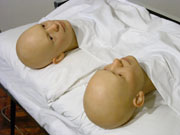
Ken Feingold, You
Talking heads
Ken Feingold’s artificially intelligent sculpture
BY NINA MACLAUGHLIN

Ken Feingold, You
Art exists to be talked about. The works of Ken Feingold are notable because they talk back. Feingold, the recipient of a Guggenheim Fellowship, is both an accomplished sculptor and a better-than-average computer programmer, and he makes use of both talents to produce works depicting an array of artificially intelligent and sometimes quite lifelike creatures. In three new works that will be on display at the School of the Museum of Fine Arts next weekend through October 23, Feingold uses animatronic heads and conversationally capable puppets to search out the essence of what it means to be human, exploring sex, death, violence, and our ability (or lack thereof) to communicate.
In all his work, Feingold programs his creations so that the conversations are continually changing: the robots’ dialogue, he has said, is neither scripted nor random, but instead designed to mimic "personality": "a vocabulary, associative habits, obsessions, and other quirks ... which make their conversations poetic, surprising, and often hilarious," he told the SMFA curators. And despite masterminding the programming behind what these robots say, Feingold himself doesn’t know exactly what will come out of their mouths. "They surprise me all the time," he says, over the phone. "For me, that’s a measure of if the piece is successful."
Eros and Thanatos at Sea, the most visually complicated and sexually charged of the three pieces, features a group of ventriloquist puppets tangled up in a fishing net. "We’ve all got this raw material inside that fuels how we react to others," Feingold says, "and this focuses on the erotic side of it." The puppets talk to each other about sex, about their fantasies, what they want to do or have done to them. The language ranges from metaphoric ("I want to look up at the stars and feel your universe rubbing on my flower") to imperative ("Move over to the corner then lean onto the sofa") to the essential ("higher, faster, slower, there"). "The whole sexual panorama together is sort of like being at an orgy or a cocktail party," Feingold says.
In Feingold’s The Animal, Vegetable, Mineralness of Everything, three lifelike robot heads, all self-portraits, stretch like a sinister hydra and contemplate an abstract mass of black orbs while discussing the nature of violence. "They don’t know what it is and they all want to figure it out," Feingold says. "It’s a metaphor for art, for our own unconscious mind. It’s about how we project our sense of the universe onto the universe."
You features two identical heads resting on pillows on a kitchen table. The two — one with a male voice and the other with a female voice — engage in a circular argument, running back and forth: you do this; you do that; you’re always; you’re never; and so on into the proverbial make-up, then back into blame. "It’s about the anguish of trying to be close to other people," Feingold says.
For all their conversational intricacies, there’s just something profoundly eerie about talking, disembodied heads. "There’s a level of discomfort with having something that’s dead matter speaking and acting like something alive," Feingold agrees. "People think of puppets as cute and funny. These ones make you ask what it would be like if everything in the world started talking, if we weren’t the only ones in the privileged position of talking. There’s a kind of creepiness to that."
"Ken Feingold: New Works" runs September 10 through October 23 at the Grossman Gallery at the School of the Museum of Fine Arts, 230 the Fenway, in Boston, with a reception September 9 from 5 to 7 p.m. Call (617) 369-3718.
The Boston Phoenix
Issue Date: September 3 - 9, 2004
Ken Feingold | artworks | catalog | reference texts | contacts
image copyright © 1998-2004 all rights reserved